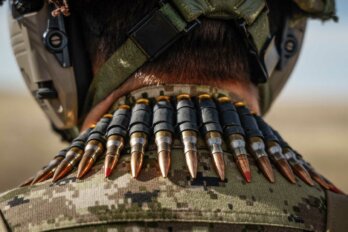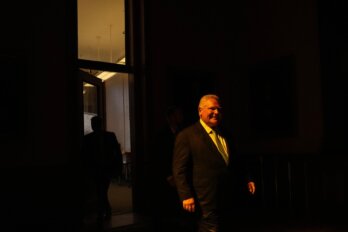Just over two years ago, I tried to retire from writing about mass violence. A truck had just plowed through a crowd celebrating Bastille Day in Nice, France. Scores were dead. The carnage, images of which were rapidly shared online, was horrific. It was just the latest in a series of terror attacks inspired by Islamic State militants in Europe. After almost a decade in journalism, and probably a dozen or more columns on the subject of violence, I’d simply run out of things to say. That’s not great when you’re a full-time columnist, as I was then with the National Post. But there wasn’t any new angle to explore. I was fresh out of reassuring words.
I’d hit my limit for mass shootings seven months earlier. That was in the aftermath of another bloodbath, this one also apparently inspired by ISIL. Syed Farook and Tashfeen Malik had killed fourteen of Farook’s colleagues and wounded twenty-two others in a mass shooting in San Bernardino, California. The talking points about gun control, workplace violence, radicalization, and mental health were completely stale and warmed over, but I couldn’t get too angry about that. I had nothing new to offer either.
I noted in a column then, “You could see it in the interviews the shaken eyewitnesses gave on TV. The answers were perfect soundbites, tailored for breaking news coverage, and why not? We’ve seen it all so many times before, it may as well be scripted….We all know our lines and deliver them on cue. We all have our theories and our biases, and if the facts don’t support us this time, hey, maybe the next one will, and it’s right around the corner.”
That was it for me. I was done. I’d nothing left to say.
And then, on Sunday night, I heard the sirens.
It would be an exaggeration to say the shooting on Danforth happened right in my backyard. I’m about a ten-minute drive away, across the Leaside Bridge and on the other side of the Don Valley Parkway. But I still knew right away that something had happened Sunday night. I was at home, working in my basement office. It was a bit after ten. We live just a few blocks from Sunnybrook Hospital, and a fire station is another few blocks away. The neighbourhood was suddenly full of sirens. Many, many sirens. Nothing like we’d ever heard before. My wife and I stepped outside to see what was happening. We saw ambulances racing at incredible speed down normally sleepy streets. Some were under heavy police escort.
We went inside and turned on the TV news. But we already knew. Toronto had been hit. Again.
Just three months after the van attack in northern Toronto, a shooter had attacked the Danforth, an area known for its restaurants, parks, and night life. Two were killed, we know now, including an eighteen-year-old woman and a ten-year-old girl. Thirteen more were injured, some critically. A shooter was dead after exchanging gunfire with police. The twenty-nine-year-old, identified as Faisal Hussain, “had severe mental health challenges,” according to a statement from his family, which also expressed their profound condolences and said that efforts at treatment had failed to help their son.
These are the details. They’re important, especially for the families devastated by this. But they’re also shockingly ordinary. Almost banal.
Around the crime-scene perimeter Monday, with yellow tape at every intersection and laneway, there was emotion. One man walked up the tape near a throng of restless journalists and bored cops and stood there for a moment before bursting into tears. He wasn’t the only one crying in public, especially at the tape.
But move a few steps away from the tape, and the cityscape returned to normal shockingly fast. Most of Toronto didn’t need to get back to normal. With the exception of a tiny part of the city, the part that was actually cordoned off, it never wasn’t normal.
The same was true after the attack in North York last April. Two stunning attacks, in bustling neighbourhoods, in only three months. Both times, once you walked a few feet away from the scene, life appeared routine. This is Keep Calm and Carry On taken to such an extreme that no posters are needed to remind us.
If there was one scene that summed up how well Toronto coped with this latest tragedy, it came in the form of a group of young children. I’d gone to Logan Avenue, as close as I could to one of the shooting sites. Ontario’s Special Investigations Unit had had a press conference there earlier, offering up little beyond saying the investigation will take time. A helpful citizen had hung a sign on his front fence, along with an extension cord, telling the media and first responders to charge their phones if necessary. For me, it was.
As I stood there, borrowing a stranger’s power, the kids marched down the street in matching T-shirts, under the watchful gaze of cheerful camp counsellors. The campers were excited by all the activity—the police cars, the TV-news satellite trucks, and the choppers above. They were pointing and laughing. One young fellow, who couldn’t have been more than ten years old, was talking so fast I struggled to understand what he was saying. But, as he got closer, I could make it out.
“In Syria,” he was telling his friends, “our teachers used to teach us to duck if we were being shot at!” He hammed it up, theatrically miming ducking and making machine-gun sounds. “It was scary!” he said. The other kids laughed. “Bombs are worse,” he added conversationally, marching past me and out of earshot. His friends smiled but didn’t say much.
How did we get here? I wondered. When I was a young guy, hearing someone who’d actually been near a war, describing shootings and bombs and battles, would have fascinated me. I would have wanted to know every last detail. But these kids, these flowers of Toronto’s youth, didn’t seem that interested.
My God, I thought. Are the kids…are the kids just expecting this to happen here?
If I heard one thing Monday walking the streets at and around the scenes of the crime, it wasn’t shock or horror or anger. It was acceptance, sometimes infused with something frighteningly close to civic pride. It was hard for me to put my finger on it precisely, but again and again, I spoke with people who seemed to have taken the attitude that Toronto, as a big city, simply has to expect things like this to happen.
In these conversations, there was a shocking apathy toward what the actual explanation for the attack was. Terrorism? Gang violence? A lone-wolf shooter, gripped by mental illness? In a contrast to the tweets and posts on Facebook—which coursed around the city to across the country, expressing anger, sympathy, and opinions, in a way that uniquely suited the medium—on the ground at the Danforth, people were curious but not particularly focused on the why. They were just resigned to that it had happened and wanted to get back to work.
Admittedly, I’ve spent a career professionally immersed in these things—literally, have been paid to account for and make sense of mass violence. As a journalist, I found the lack of engagement on the part of others to draw big questions and conversations from it baffling and, I admit, frustrating. That day, I wanted these people who had seen violence first-hand to care more. Not to be traumatized, of course. But I wanted to see signs of engagement or curiosity or a focus on policy. There wasn’t any. People were instead determined to get local businesses open again, to show support for the community, and then to go home. On the human level, it was inspiring to see. But hugs and dinners out won’t stop the next one of these events from happening.
A police officer captured the mood. He was standing at an intersection that had been closed. I was chatting with him. Mostly small talk. He told me, though, out of the blue, “You know, I’ve done shootings before. Lots of shootings. But this…nothing like this.” I asked him if he was okay, and he seemed surprised. “Oh, yeah, of course,” he said, and he meant it. He knew something like this would happen, he said. It was only a matter of time.
So many major cities have been attacked in recent years that they’ve all been preparing to respond to this level of violence. On Sunday, the shooter was intercepted within minutes and engaged by well-armed, well-trained police. First responders evacuated the wounded and saved those who could be saved. Less than a day after the shooting, the police tape was down and the restaurants and bars opened again. I picked up dinner from Christina’s, a local restaurant, where the server told me at least one person had been hit there the night before.
I’m not bothered by the police being prepared, of course, or the hospitals and the medics being ready. What worries me is the rest of us. How many of these have we seen happen damn near live on CNN? Maybe we’ve accepted, consciously or otherwise, that this will happen here. We skip over the shock at the mere fact that this could happen. We expect this now, and we’re relieved when it’s not worse.
As I write this, it’s the next day. The streets are open now. The police have gone home. And now, the follow-up conversations have begun: about gun control, about mental illness, and motive (and how they relate) and about the balance between freedom and security in a free society more generally. Could better treatment and more social supports have prevented this or at least have provided some warning? The statement from the family says they tried to help their son. Were they failed somehow, or was some version of this inevitable?
We’ve had all these debates before after other horrific crimes—the Pulse nightclub shooting in Orlando, the recent Las Vegas massacre, and, of course, the 2014 shooting on Parliament Hill. They won’t sound much different this time. The answer to preventing mass violence like this in the future would probably involve some blend of three key tactics—better background checks for firearms-licence holders, more effort to restrict US guns, better support for mental-health care—but that’s a nuanced argument. No one has time for those in 2018, least not the politicians.
It’s no surprise that people fall back on their talking points (this was especially apparent after ISIL claimed responsibility for the attack early Wednesday morning—a claim for which the Toronto police say they as yet see no evidence). We’ve all been through these grim aftermaths so many times before that the talking points are comforting. Almost a routine. In the absence of any real expectation of major progress on possible solutions, it’s either get angry or accept it and move on.
People get angry, of course, and write op-eds or argue on Twitter or write letters to their local MP. It happens. But in the Danforth on Monday, there was less than palpable sense of anger, in a civic sense, than I expected. No one demanding this or that policy tweak. Just people who were glad it was over. And hopeful it wouldn’t come back again.





